‘Springfield’ Category
» posted on Monday, May 20th, 2013 by Linda Lou Burton
As Pretty As Ours
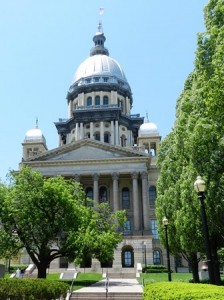 Linda Burton posting from Springfield, Illinois – The grass was so green it commanded my attention. The sweet smell of spring hedge assailed my senses the minute I stepped from the car; the grass added a visual blast; wow, what did the groundskeeper do to get such green? The wind sent my hat sailing; I chased it across the lawn, wanting to stop and sit right in the middle of that luscious grass. But I plopped it back onto my head, secured the string, and kept walking; I had a purpose. Past the statue of Stephen Douglas, up a few steps, into the doors of the building that has served as this state’s capitol since 1877. The two men at security waved me towards Xray; “Where are you from?” one
Linda Burton posting from Springfield, Illinois – The grass was so green it commanded my attention. The sweet smell of spring hedge assailed my senses the minute I stepped from the car; the grass added a visual blast; wow, what did the groundskeeper do to get such green? The wind sent my hat sailing; I chased it across the lawn, wanting to stop and sit right in the middle of that luscious grass. But I plopped it back onto my head, secured the string, and kept walking; I had a purpose. Past the statue of Stephen Douglas, up a few steps, into the doors of the building that has served as this state’s capitol since 1877. The two men at security waved me towards Xray; “Where are you from?” one 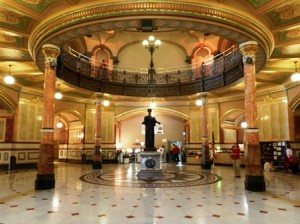 asked as my bag went through. I told them about the Journey. “This is my thirty-first capitol,” I said. “Is any other one as pretty as ours?” inquired the one whose badge told me he was Fred. “Well, you’ve got the best grass I’ve ever seen!” I laughed. “We’ve got the highest dome,” he said. “It is 74 feet higher than the national capitol.” “It’s shaped like a Greek cross,” Robert added, “and it is the sixth capitol we’ve had. The first was in Kaskaskia.” Fred picked up a
asked as my bag went through. I told them about the Journey. “This is my thirty-first capitol,” I said. “Is any other one as pretty as ours?” inquired the one whose badge told me he was Fred. “Well, you’ve got the best grass I’ve ever seen!” I laughed. “We’ve got the highest dome,” he said. “It is 74 feet higher than the national capitol.” “It’s shaped like a Greek cross,” Robert added, “and it is the sixth capitol we’ve had. The first was in Kaskaskia.” Fred picked up a 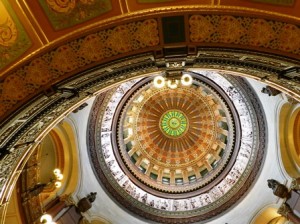 brochure; “It cost $4,315,591 to build,” he read, “and they used 3.4 million pounds of cast iron in it.” “You guys aren’t Security, you’re PR,” I told them; “where should I start?” They directed me straight ahead, across the rotunda to the Visitor Desk. “And look up,” Fred urged. “There are 9,000 pieces of stained glass in the dome.” I walked past the open-armed statue of Illinois Welcoming The World, and looked up. » read more
brochure; “It cost $4,315,591 to build,” he read, “and they used 3.4 million pounds of cast iron in it.” “You guys aren’t Security, you’re PR,” I told them; “where should I start?” They directed me straight ahead, across the rotunda to the Visitor Desk. “And look up,” Fred urged. “There are 9,000 pieces of stained glass in the dome.” I walked past the open-armed statue of Illinois Welcoming The World, and looked up. » read more
» posted on Friday, May 17th, 2013 by Linda Lou Burton
Little House On The Prairie
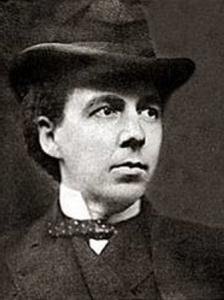 Linda Burton posting from Springfield, Illinois – Frank Lloyd Wright (1867-1959) was a man who dared to be different. And as with anyone who puts forth new ideas, he was controversial. In 1893 Frank left the office of his mentor, Louis Sullivan, and began to practice as an independent architect. Frank believed that rooms in Victorian era homes were boxed-in and confining, so he began to design houses with low horizontal lines and open interior spaces, aiming for congruence between the interior of a building and its surroundings. In the 1901 Ladies Home Journal, a Frank Lloyd Wright houseplan called “A Home in Prairie Town” was featured; thereafter Frank’s concept became known as “Prairie Style.” It was fitting; prairie houses were meant to blend with the flat prairie
Linda Burton posting from Springfield, Illinois – Frank Lloyd Wright (1867-1959) was a man who dared to be different. And as with anyone who puts forth new ideas, he was controversial. In 1893 Frank left the office of his mentor, Louis Sullivan, and began to practice as an independent architect. Frank believed that rooms in Victorian era homes were boxed-in and confining, so he began to design houses with low horizontal lines and open interior spaces, aiming for congruence between the interior of a building and its surroundings. In the 1901 Ladies Home Journal, a Frank Lloyd Wright houseplan called “A Home in Prairie Town” was featured; thereafter Frank’s concept became known as “Prairie Style.” It was fitting; prairie houses were meant to blend with the flat prairie 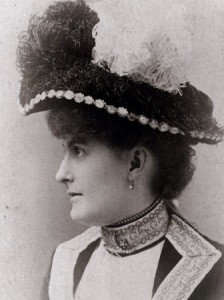 landscape. Susan Lawrence Dana (1862–1946) was an independent woman and heiress to a substantial fortune, including silver mines in the Rocky Mountains. Widowed in 1900, Susan enjoyed complete control over her household and fortune. Eager to express her personality and to become the leading hostess in Springfield, she decided to completely remodel her family’s Italianate mansion in the state capital’s fashionable “Aristocracy Hill” neighborhood. Her search for an architect to match her aspirations ended when she was introduced to Frank Lloyd Wright, at the time considered the rising leader of a new movement. Susan’s 1902 commission to Frank for the remodeling of the Lawrence Victorian mansion was the largest commission he had ever received. The personalities and tastes of the two were a perfect match; Frank wound up designing and building what was, in effect, an entirely new house for Susan. The house contains the largest collection of site-specific, original Wright art glass and furniture in the world; this gorgeous treasure is today a museum operated by the Illinois Historic Preservation Agency. » read more
landscape. Susan Lawrence Dana (1862–1946) was an independent woman and heiress to a substantial fortune, including silver mines in the Rocky Mountains. Widowed in 1900, Susan enjoyed complete control over her household and fortune. Eager to express her personality and to become the leading hostess in Springfield, she decided to completely remodel her family’s Italianate mansion in the state capital’s fashionable “Aristocracy Hill” neighborhood. Her search for an architect to match her aspirations ended when she was introduced to Frank Lloyd Wright, at the time considered the rising leader of a new movement. Susan’s 1902 commission to Frank for the remodeling of the Lawrence Victorian mansion was the largest commission he had ever received. The personalities and tastes of the two were a perfect match; Frank wound up designing and building what was, in effect, an entirely new house for Susan. The house contains the largest collection of site-specific, original Wright art glass and furniture in the world; this gorgeous treasure is today a museum operated by the Illinois Historic Preservation Agency. » read more
» posted on Wednesday, May 15th, 2013 by Linda Lou Burton
A Trace Of Times
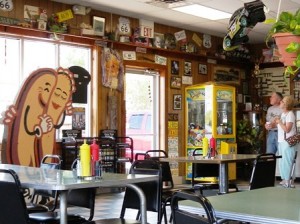 Linda Burton posting from Springfield, Illinois – It was a time warp. Two just-up cozy dogs and a side of rings sat before me on 50’s-era formica, a squirt of mustard puddled beside them in the cardboard cup. Over by the door two eight-foot cozy dogs complete with hairbow and gloves stood in loving embrace. Over in the corner two cozy customers stood mesmerized by memorabilia plastered floor to ceiling on the restaurant walls. Outside, two cozy dogs atop the sign explained: Cozy Drive In Home of the Famous Hot Dog On A Stick. And beyond that, the highway once known as Route 66
Linda Burton posting from Springfield, Illinois – It was a time warp. Two just-up cozy dogs and a side of rings sat before me on 50’s-era formica, a squirt of mustard puddled beside them in the cardboard cup. Over by the door two eight-foot cozy dogs complete with hairbow and gloves stood in loving embrace. Over in the corner two cozy customers stood mesmerized by memorabilia plastered floor to ceiling on the restaurant walls. Outside, two cozy dogs atop the sign explained: Cozy Drive In Home of the Famous Hot Dog On A Stick. And beyond that, the highway once known as Route 66  carried the midday traffic on what is now Sixth Avenue. Times may change, but the past is safe in here. I swirled my corndog in the mustard, bit off the end, and began to read the back of my newly purchased map. Route 66 runs from the shores of Lake Michigan in Chicago to the Pacific Ocean at Santa Monica, California. Begun in 1926, it was built under several Federal Aid Highway Acts and was one of the largest public works projects to take place in the US. Route 66 helped create a distribution of America’s population from the areas affected most by the great depression to
carried the midday traffic on what is now Sixth Avenue. Times may change, but the past is safe in here. I swirled my corndog in the mustard, bit off the end, and began to read the back of my newly purchased map. Route 66 runs from the shores of Lake Michigan in Chicago to the Pacific Ocean at Santa Monica, California. Begun in 1926, it was built under several Federal Aid Highway Acts and was one of the largest public works projects to take place in the US. Route 66 helped create a distribution of America’s population from the areas affected most by the great depression to 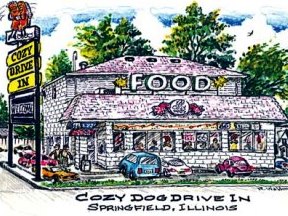 new areas in the west. From 1945-1965 many unique businesses opened along the route to service the increased travel prompted by the post-war economic boom. Restaurants, motels, and novelty shops created miles of neon signs that marked the way of Route 66. “And I’m in one of those restaurants right now,” I thought, as I unfolded the map to read about other spots along the route still there to offer nostalgic travelers a trace of times gone by. » read more
new areas in the west. From 1945-1965 many unique businesses opened along the route to service the increased travel prompted by the post-war economic boom. Restaurants, motels, and novelty shops created miles of neon signs that marked the way of Route 66. “And I’m in one of those restaurants right now,” I thought, as I unfolded the map to read about other spots along the route still there to offer nostalgic travelers a trace of times gone by. » read more
» posted on Monday, May 13th, 2013 by Linda Lou Burton
Honestly Abe
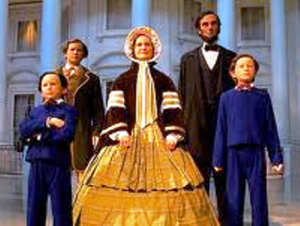 Linda Burton posting from Springfield, Illinois – “It’s like Epcot,” I was told by a Springfield resident, referring to the Abraham Lincoln Presidential Museum at the corner of Jefferson and Sixth. “You’ve got to see it!” In a town that’s filled with Abe-ness, this is the spot where every facet of the Lincoln story is presented “Disney style,” in ways designed to hold the attention of even the most blasé. Everybody knows Abraham Lincoln basics; born February 12, 1809, assassinated April 15, 1865; 16th President of the United States. His rugged face is familiar to us; he’s often portrayed wearing a top hat and a somber expression. His boyhood poverty and
Linda Burton posting from Springfield, Illinois – “It’s like Epcot,” I was told by a Springfield resident, referring to the Abraham Lincoln Presidential Museum at the corner of Jefferson and Sixth. “You’ve got to see it!” In a town that’s filled with Abe-ness, this is the spot where every facet of the Lincoln story is presented “Disney style,” in ways designed to hold the attention of even the most blasé. Everybody knows Abraham Lincoln basics; born February 12, 1809, assassinated April 15, 1865; 16th President of the United States. His rugged face is familiar to us; he’s often portrayed wearing a top hat and a somber expression. His boyhood poverty and 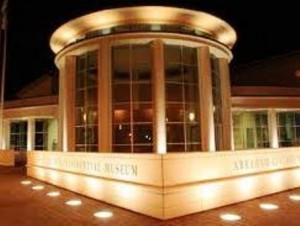 rise to leader of the land is the stuff of inspiration; “he learned to read by candlelight,” we’re told, and thus we know we can achieve greatness too, no matter how humble our beginnings, just like Abe. This is the place to kick up what you know a notch; it’s all there in an air-conditioned walk – the replica of “Abe’s Boyhood Cabin;” his courtship of Mary Todd; his children Willie and Tad playing in his office; his presidential campaign; his time in the White House; his coffin in the Springfield capitol. Special effects surround you; there’s a TV studio
rise to leader of the land is the stuff of inspiration; “he learned to read by candlelight,” we’re told, and thus we know we can achieve greatness too, no matter how humble our beginnings, just like Abe. This is the place to kick up what you know a notch; it’s all there in an air-conditioned walk – the replica of “Abe’s Boyhood Cabin;” his courtship of Mary Todd; his children Willie and Tad playing in his office; his presidential campaign; his time in the White House; his coffin in the Springfield capitol. Special effects surround you; there’s a TV studio 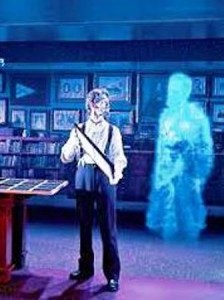 playing the 1860 presidential campaign as though it were held in modern times; a barrage of words and images depict the world that surrounded Lincoln as he sat as his desk to sign the Emancipation Proclamation. During the projection show in the Union Theater the seats tremble when Civil War cannons are fired; in Ghosts of the Library a live actor debates holographic ghosts. A fabulous experience, all in all. But here in Springfield you can see the honest-to-Lincoln sites too, like the Lincoln home, and offices. For real. » read more
playing the 1860 presidential campaign as though it were held in modern times; a barrage of words and images depict the world that surrounded Lincoln as he sat as his desk to sign the Emancipation Proclamation. During the projection show in the Union Theater the seats tremble when Civil War cannons are fired; in Ghosts of the Library a live actor debates holographic ghosts. A fabulous experience, all in all. But here in Springfield you can see the honest-to-Lincoln sites too, like the Lincoln home, and offices. For real. » read more
» posted on Friday, May 10th, 2013 by Linda Lou Burton
Love What You’ve Got
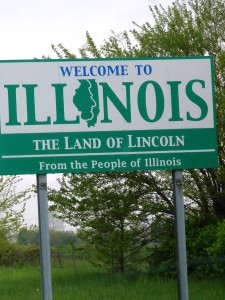 Linda Burton posting from Springfield, Illinois – I woke in Indianapolis today; from my room overlooking the city I watched the sun rise in the morning window-sparkle of downtown skyscrapers. I sleep tonight in Springfield; outside my room a single tree somewhat blocks my view of the long-haul trucks in the parking lot, waiting for daylight to hit the road. Though both cities are the center of government for their state, they are very different in style. Indianapolis (pop 829,718) thrives on the adrenalin of sports; speedways and stadiums dot the landscape, surrounded by the accoutrements that accommodate large crowds; restaurants of every ilk, high-rise hotels, taxi cabs. Stand and cheer! Springfield (pop 116,250) is Lincoln’s land; everywhere is evidence of the quiet reflective man who lived here, is buried here. In Springfield he practiced law; in Springfield he campaigned to become president of the land, though when he arrived he didn’t have money to even buy a bed. Inspiration of a different sort; such is the way of the Journey Across America, now 60% complete (stand and cheer!). Today I claim 30 capital cities as my home towns; for the last 443 days I’ve experienced life with big-city bustle, and small-town charm. I’ve seen mountains and
Linda Burton posting from Springfield, Illinois – I woke in Indianapolis today; from my room overlooking the city I watched the sun rise in the morning window-sparkle of downtown skyscrapers. I sleep tonight in Springfield; outside my room a single tree somewhat blocks my view of the long-haul trucks in the parking lot, waiting for daylight to hit the road. Though both cities are the center of government for their state, they are very different in style. Indianapolis (pop 829,718) thrives on the adrenalin of sports; speedways and stadiums dot the landscape, surrounded by the accoutrements that accommodate large crowds; restaurants of every ilk, high-rise hotels, taxi cabs. Stand and cheer! Springfield (pop 116,250) is Lincoln’s land; everywhere is evidence of the quiet reflective man who lived here, is buried here. In Springfield he practiced law; in Springfield he campaigned to become president of the land, though when he arrived he didn’t have money to even buy a bed. Inspiration of a different sort; such is the way of the Journey Across America, now 60% complete (stand and cheer!). Today I claim 30 capital cities as my home towns; for the last 443 days I’ve experienced life with big-city bustle, and small-town charm. I’ve seen mountains and 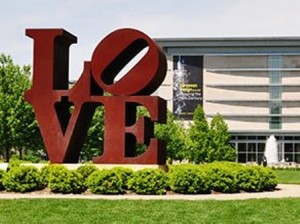 valleys and rivers and lakes, fishing and farming and mining and making things, fresh air and fresh food and history and her story, progress and dropping back and growth and decline, sun belts and bible belts and rust belts and no belts at all, just space. Or congestion. I knew capital cities would be interesting; I had no idea how such a mix of lifestyles and scenery and climate would affect my sensibilities, and begin to explain the world. It’s not what you’ve got that matters, I’ve discovered, it’s how much you love what you’ve got. » read more
valleys and rivers and lakes, fishing and farming and mining and making things, fresh air and fresh food and history and her story, progress and dropping back and growth and decline, sun belts and bible belts and rust belts and no belts at all, just space. Or congestion. I knew capital cities would be interesting; I had no idea how such a mix of lifestyles and scenery and climate would affect my sensibilities, and begin to explain the world. It’s not what you’ve got that matters, I’ve discovered, it’s how much you love what you’ve got. » read more
